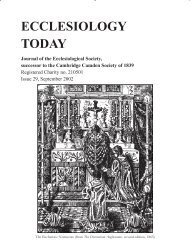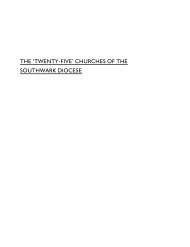PARISH CHURCHES? how do we keep our - Ecclesiological Society
PARISH CHURCHES? how do we keep our - Ecclesiological Society
PARISH CHURCHES? how do we keep our - Ecclesiological Society
Create successful ePaper yourself
Turn your PDF publications into a flip-book with our unique Google optimized e-Paper software.
HOW DO WE KEEP OUR <strong>PARISH</strong> <strong>CHURCHES</strong>? • KEEPING CHURCH BUILDINGS IN GOOD REPAIR 35<br />
AN IMPORTANT VICTORIAN CHURCH<br />
Recently I paid my #rst visit to a <strong>we</strong>ll-known<br />
nineteenth-century church, built by a famous architect.<br />
It is a stunning building.<br />
It is also large. Far, far larger than the typical Sunday<br />
congregation of about 25 actually needs. In fact, the<br />
building has not been anything like full on Sundays for<br />
at least #fty years. It may never have been.<br />
Over the last decade or so, large sums of money have<br />
been spent on it, totalling somewhere in the very high<br />
six #gures. Another six #gure sum is now required.<br />
What should <strong>we</strong> <strong>do</strong> with the building? It has<br />
wonderful acoustics: but concerts <strong>do</strong> not draw<br />
suf#ciently large attendances to make them worthwhile.<br />
Thought is being given to creating a meeting room by<br />
enclosing a space at the <strong>we</strong>st end. Will this spoil the<br />
interior?–Iamnotquali#ed to say. It may indeed be<br />
the best solution, providing a useful space for local folk<br />
whilst helping <strong>keep</strong> the building alive.<br />
But I am left with the feeling that for buildings of this<br />
importance <strong>we</strong> need different mechanisms, which will<br />
allow the congregation to continue worshipping there<br />
without pretending that they are going to be able to<br />
maintain the building themselves; and will, perhaps,<br />
make more of the potential to attract visitors.<br />
Trevor Cooper<br />
It seems likely that, on average, small congregations will<br />
be the ones which are least able to raise funds for large<br />
repairs, or to carry out routine maintenance.<br />
In addition, the smaller the congregation, the more<br />
likely they are to have to share clergy with other<br />
congregations, diluting an important s<strong>our</strong>ce of leadership.<br />
Looking at the rural situation, in 1994 more than one<br />
third (36%) of very small rural communities – those with<br />
fe<strong>we</strong>r than 200 inhabitants – had a vicar who looked after<br />
#ve or more churches (Table 3.7). Overall, I estimate that<br />
there <strong>we</strong>re approximately 1,700 rural communities in<br />
England sharing their vicar with at least f<strong>our</strong> other<br />
churches. Since then the number of clergy has dropped<br />
faster than the number of church buildings, so there are<br />
presumably even more clergy and churches in this<br />
situation today.<br />
The clergy in this position will have less time to devote<br />
to each of their church buildings. In one study, <strong>do</strong>ne in<br />
Table 3.7<br />
Number of rural churches with vicar who has care of five or<br />
more churches, by population of community (1994)<br />
Churches with vicar caring<br />
Population of community for five or more churches<br />
% Number<br />
Up to 200 36 590<br />
200–399 27 550<br />
400–899 17 390<br />
900–3000 8 180<br />
Overall 21 Total =<br />
1700<br />
S<strong>our</strong>ce: Francis and Martineau, Rural Mission, Table 3. For number of<br />
churches, see Appendix E.<br />
FINANCIAL PRESSURES ON <strong>PARISH</strong>ES<br />
These are quotes from churches responding to Jeremy Eckstein’s<br />
questionnaire, undertaken as research for his 2001 report. These<br />
have been selected as representative of those churches #nding it<br />
dif#cult to fund all recommended repairs. Each of these cases<br />
represents a set of worries for real people looking after a historic<br />
building with inadequate funds. We <strong>do</strong> not know what<br />
proportion of churches found themselves in this position.<br />
• Work on guttering and <strong>do</strong>wnpipes was not attended<br />
to, mainly because of unanticipated need for<br />
re-wiring, heating and lighting (£10,000) and<br />
redecorating (£8,000).<br />
• No major work was identi#ed as being required.<br />
Ho<strong>we</strong>ver there is currently a requirement for £15,000<br />
for organ repairs, £11,000 for re-wiring and £6,000<br />
for stonework on gables – £32,000 in all, for which<br />
<strong>we</strong> have available funds amounting to £12,000.<br />
• Following massive water penetration, work was<br />
carried out to repair/replace sections of roof, at a total<br />
cost of £12,000 – of which £8,500 was raised locally.<br />
Medium plan is now to carry on improving water<br />
run-off/roof. Funding is now a problem, as total cost<br />
was estimated at £50,000 and grant-aid is no longer<br />
available. We are trying to complete fund-raising for a<br />
new hall, so efforts to continue with repairs will have<br />
to cease until that is <strong>do</strong>ne.<br />
• [After a major fund-raising initiative for urgent<br />
repairs.] The fund-raising team was exhausted by the<br />
end of Phase II, and <strong>we</strong>re given #ve years to<br />
recuperate and enjoy what they had achieved.<br />
S<strong>our</strong>ce: Eckstein (2001)<br />
1989, about 150 multi-church clergy <strong>we</strong>re asked to list up<br />
to #ve disadvantages of having multiple church buildings.<br />
Unprompted, more than half mentioned the pressures of<br />
looking after several buildings, often Grade I, and the<br />
associated #nancial strains. “Fabric takes a<br />
disproportionate time,” complained one minister. Another<br />
said that one result of having many church building was<br />
that it meant “getting to know a lot of architects” ! 8<br />
Furthermore, one third of rural vicars (32%) are aged<br />
over sixty (1994 study), and this may also have an impact<br />
on the energy they are able to devote to organising<br />
large-scale, long-term fund-raising and church repairs<br />
(though the opposite might also be true: their experience<br />
may mean they #nd the process less of a struggle). 9<br />
In the light of these considerations, I was somewhat<br />
surprised by my analysis of last year’s grants by EH/HLF to<br />
small rural congregations. I found that grants <strong>we</strong>re awarded<br />
to smaller rural communities in more or less the same<br />
proportion as those communities occur. That is, small<br />
communities <strong>we</strong>re not under-represented. I have not had<br />
the opportunity to analyse grant requests, to see if they<br />
s<strong>how</strong> the same pattern. It is possible that they are<br />
under-represented in applications, but that they are more<br />
likely to make it through the selection process, which<br />
allows for urgency and #nancial need.<br />
These problems are not limited to rural churches, but<br />
similar data for urban churches is less easily available. We<br />
badly need a review of the dif#culties which parishes of all










